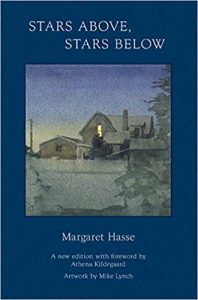
Published by Nodin Press
Margaret Hasse’s collection Stars Above, Stars Below was originally published in 1984, then reprinted in 2018 with an additional foreword and afterword. Stars Above, Stars Below earned classic status as Hasse’s breakthrough collection, beginning what turned out to be a long career in writing, teaching, and building community around creative writing. I highly recommend reading the foreword and afterword of this collection; they explain Hasse’s many contributions to Minnesota’s writing community, creating another layer of connection to the author in this already deeply-personal collection. Stars Above, Stars Below also contains several pieces of artwork by Minnesota painter Mike Lynch—each painting begins a section of the collection. Hasse’s collection is aided by the inclusion of these visual works, especially relating to themes of solitude and domestic life.
Each section in this collection—”The Garden at Dusk,” “Secrets and Rumors,” and “Open Windows”—flourishes with unlikely images and moments of surprise. Juxtaposed against domestic and rural (read: ordinary) settings, Hasse highlights fresh moments inside familiar contexts, forcing the reader to question routine, domesticity, and assumption. A magical example comes from the poem “Night Game at Parade Stadium,” where Hasse reimagines the setting of a baseball field and the image of a pack of cigarettes: “When the game’s over and the lights are cut, / you think you see the shiny back of a coin. / It’s only a cigarette package / catching a star / in its cellophane wrap.”
In the midst of creating unlikely images, Hasse also forces her reader to face uncomfortable questions. Themes of violence, loss, and confinement populate Stars Above, Stars Below, often manifesting as questions. How do you say goodbye to a place? How do you console a friend whose husband has just left her? When a jogger stumbles across a dead body in “The Man in the Grass,” Hasse asks the reader, “What rots first on the man in the grass?”
Hasse also considers themes of loneliness and solitude in this collection. As the sections progress, the speaker grows increasingly comfortable being alone. This theme reaches a climax in the poem “Exit Alone.” My favorite lines conclude the first stanza—they read, “The revelation of orange, of eating and drinking / and going to a film alone: certain colors / are seen only when a person is alone.” Even when Hasse is sentimental, I appreciate that her observations remain practical and forthright. Additionally, the simple language of this collection aids its timelessness. While Hasse’s themes are sophisticated, her words and images are accessible and inviting.
As the collection switches between each of the three sections, Hasse alternates personal and general narrative voices. While the section “Secrets and Rumors” includes a wide variety of speakers and perspectives, “The Garden at Dusk” and “Open Windows” seem more rooted in the author’s personal experience. This internal shift is revealed in full in the poem “Meditation on a Cold Rain” when the speaker declares, “I stay inside. I am inside. I am Margaret.” While Hasse may be hesitant to identify herself as the “I” of her poems—saving the announcement for the final section—she cultivates vulnerability and intimacy with her reader by owning the collection as her own coming-of-age story.
Hasse balances heartbreak and wonder in Stars Above, Stars Below, aligning the familiar with the uncomfortable to create a collection of timeless poems. Hasse’s first full-length contribution to poetry established her vocabulary as one of observation, perseverance, and longing—one that strives to describe magic in everyday moments. The collection is perhaps best encapsulated in the poem “Being Still,” which ends by saying, “The stiller she is the more everything moves / in the immense vocabulary of being.”–Connor Poff